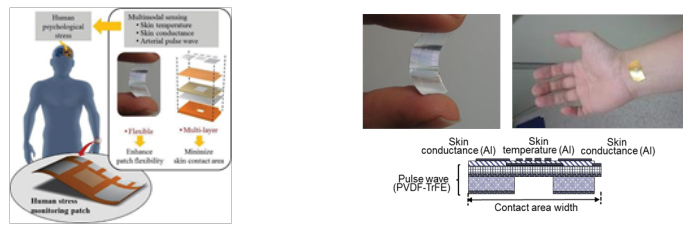Professor Young-Ho Cho’s research team is developing Human emotion monitoring skin patches.
A human stress monitoring patch integrates three sensors for skin temperature, skin conductance, and pulsewave in the size of a stamp (25 mm × 15 mm × 72 μm) in order to enhance wearing comfort with small skin contact area and high flexibility. The skin contact area is minimized through the invention of an integrated multi-layer structure and the associated microfabrication process, thereby being reduced to 1/125 of that of the conventional single-layer multiple sensors. The patch flexibility is increased mainly by the development of a flexible pulsewave sensor, made of a flexible piezoelectric membrane supported by a perforated polyimide membrane. In the human physiological range, the fabricated stress patch measures skin temperature with a sensitivity of 0.31 Ω/°C, skin conductance with a sensitivity of 0.28μV/0.02 μS, and pulse wave with a response time of 70msec. The skin-attachable stress patch, capable of detecting multimodal bio-signals, shows potential for application to a wearable human emotion monitoring system.
The cognitive piloerection sensors are developed to monitor human emotional impression by measuring the goose bumps appearing on human skin. It is demonstrated experimentally that the interlocking spiral electrodes of the piloerection sensors are effective to measure the goose bumps at a sensitivity of 00252%/μm in a range of 0~318μm. The high wearability of the flexible sensors offers strong potential for application to interactive human emotional communication devices and human-machine cognitive interface systems.
A portable sweat rate sensor is developed by integrating a thermo-pneumatic actuator for daily human thermal status monitoring. The portable sweat rate sensor, having a size of 38 ± 0.5 mm × 41 ± 0.5 mm × 29 ± 0.5 mm with a total weight of 63 ± 1 g, is capable of lifting the humidity chamber 1.91 ± 0.27 mm above the skin in a movement period of 3 min. The present sensor measures the sweat rate with a sensitivity of 0.056 (pF/sec)/ (g/m2h) and a linearity of 99.1 % in a sweat rate range of 3.76~137.68 g/m2h.


Prof. Young Ho Cho (Department of Bio and Brain Engineering)
Homepage: https://mems.kaist.ac.kr
E-mail: mems@kaist.ac.kr






